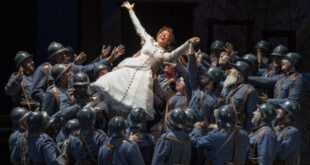As any music historian will tell you, composer Gaetano Donizetti didn’t intend his three operas about Tudor queens as a trilogy. Written in separate years with different librettists, the operas focus on climactic and at times highly fictionalized moments in the lives of Anne Boleyn in “Anna Bolena,” Mary Queen of Scots in “Maria Stuarda” and Queen Elizabeth I in “Roberto Devereux.” While long looked upon individually as proving grounds for the greatest divas of our time, the trio was forever linked when Beverly Sills sang all three roles with the New York City Opera in the 1970s.
Jumping forward a half a century, soprano Sondra Radvanovsky took the feat to the next level. A mainstay at major opera houses around the globe, the Chicago-area native has portrayed famous leading ladies from Aida to Violetta, and by the spring of 2016 she had performed the operatic “triple crown” at the Metropolitan Opera in a single season. Not to be outdone, the Lyric Opera of Chicago gave Radvanovsky the opportunity this December to bring the three queens to life in a single evening. Performed a mere three times over the course of a week, the unique semi-staged production was a complete triumph — both for the diva and the company as a whole.
Crafted for maximum impact, the production was the brainchild of Radvanovsky herself and Italian Maestro and bel-canto specialist Riccardo Frizza. Organized chronologically, both in terms of when they were composed and when the historical events occurred, each selection excerpted the overture, followed by the final scene of the final act, creating a series of operatic bookends. This created a beautiful arch to the evening, particularly considering each heroine was older than the last in their climactic scene: Anne Boleyn was no more than 35 when she was beheaded, while Mary Stuart was 44 upon her execution, and Elizabeth I was in her late 60s when she sentenced her lover Robert Devereux to death.
During the overtures, the scene was cleverly set by bold text statements projected on a black scrim at the front of the stage, giving each opera’s outline in brief, timed to shifts in the music. What initially drew giggles from the audience proved highly effective at keeping their attention, and helped tremendously in the transition to the final moments of each opera. The stage was set minimally with a single piece of scaffolding and a handful of moveable staircases, using projections again to create simple graphic backdrops of castle interiors. Everything was black and muted until the diva appeared.
Before she uttered a note, Radvanovsky commanded the stage in three dramatic, monochromatic couture gowns by American designer Rubin Singer. The stunning pieces of fashion gave a nod to their era of inspiration, but primarily served to make Radvanovsky larger than life. As soon as she opened her mouth, the Civic Opera House was in her thrall, spellbound by one of the finest showings of sheer vocal talent to grace the Lyric stage. Though fighting a cold, Radvanovsky only wavered for a few brief moments, underscoring the fact that she is truly a force to be reckoned with. From the most delicate pianissimo to the most fiery forte, she excelled at the vital task of differentiating the three women in color and personality: Anne was youthful, wild and chilling in her madness. Mary was warm, rich, and stoic in her fate. Elizabeth was equal parts defiant and fragile, and ultimately shattered by the ramifications of her own proclamation. It was an emotional tour de force condensed into two hours.
Special mention should be made of the Lyric’s Chorus, which was given the rare opportunity to be front and center — quite literally. Stripped of colorful costuming and other stage trappings, one could really appreciate the artistry of the ensemble. Current members of the Ryan Opera Center also stepped in to cameo the other main characters of each opera, holding their own next to Radvanovsky, particularly in “Roberto Devereux.” The Lyric Opera Orchestra played flawlessly throughout under the baton of Maestro Frizza.
Radvanovsky has earned a place in the history books alongside Sutherland and Callas, and “The Three Queens” offered living proof. Do not despair if you missed this triumph: Radvanovsky can be heard again on the Lyric stage as Lisa in Tchaikovsky’s “Queen of Spades” Feb. 15 through March 1. For details, click here.
 Fra Noi Embrace Your Inner Italian
Fra Noi Embrace Your Inner Italian







